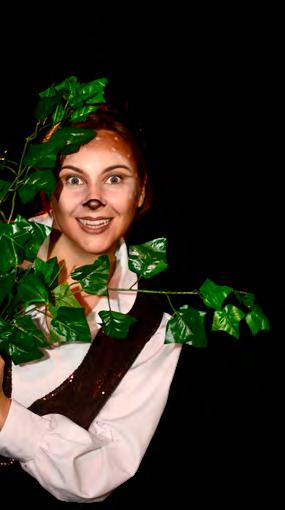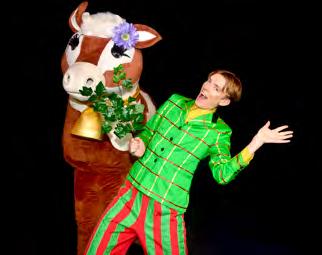
5 minute read
IT’S PANTO TIME The history of Pantomime and of The Hong Kong Players
It’s Panto Time,
Oh Yes It is!
Advertisement
Playtimes meets with The Hong Kong Players to discover how they came about, and to get the low down on how they create their annual pantomime
It’s with great passion that Hong Kong Player (HKP) chair, Giuliana Colarossi, and the rest of the team share how the HKP were formed as well as what’s in store for this year’s Panto. Let’s just say you’re in for a real treat! In 1844 there was a group of Englishspeaking expats who formed The Hong Kong Amateur Dramatic Club which was active until the second world war. After the war in 1946, the Hong Kong Stage Club was founded by Service members and eventually became the new acting society, receiving actors and the remaining Amateur Dramatic Club funds. The Hong Kond Stage Club, along with another group called the Garrison Players, were theatrically active in Hong Kong in the period after the end of World War II and for the following 50 years. These groups put on theatre performances in the city and alternated performing the Panto, sometimes joining forces for the annual show. These two dramatic societies eventually merged in 1991, forming the Hong Kong Players. So it can be said, the HKP have been the longest running English-speaking community theatre group in Hong Kong. Although they have been known by other names, their mission has remained constant. “To provide opportunities to create, perform and promote community theatre in Hong Kong.” In the spirit of their predecessors, the HKP have continued to run three to four productions per year, ranging from the classics of Shakespeare to modern drama and comedy. The annual Panto is their main performance of the year and most certainly the most fun. The very first HKP Panto was Alibaba in 1899. Since 1961 they have done Pantos every year, marking 60 years of consecutive annual pantos this year. Even the pandemic didn’t stop the HKP from performing, albeit in a different format. Last year, the Panto was performed in the HKP rehearsal studio and put online for a live virtual audience. This year is the 60th anniversary and it will be back in front of a live audience. Amy Percival, director of this year’s Panto, and Jaime Wilkin, one of the ‘Players,’ spill the beans on The 2021 Panto – it’ll be an unforgettable performance of “Jack and the Beanstalk” at the Shouson Theatre so get the family ready to Fee Fi Fo Fum their way through it with laughter, tears, singing and dancing. This year reveals a new Panto Dame, argueably the most popular character in any Panto. This year’s Panto also features 16 year old Sabine in her first Panto performance.
Speaking of beans, HKP will have a collection point for Feeding Hong Kong at the theatre. Please bring along a can of non-perishable food (maybe beans?) or rice to donate when you come for the show. An important aspect of the HKP core values is joining together to support those in need. Another facet of the HKP mission, vision and core values is to engage the Hong Kong community through community projects. They currently run mini Pantos with the down syndrome association and host Quarterly Quiz Nights at bars around Hong Kong. Join them for some good old-fashioned fun.


2021 Panto Sneak Peak on YouTube: https://youtu.be/y7CsZW8Zcig
JACK AND THE BEANSTALK PANTO
Friday, 3 December: 8pm Saturday, 4 December: 3pm and 8pm Sunday, 5 December: 11am and 3pm Thursday, 9 December: 8pm Friday, 10 December: 8pm Saturday, 11 December: 3pm and 8pm Sunday, 12 December: 11am and 3pm
The HKP has open auditions yearround for adults, teens and kids. They are also on the lookout for writers. If you’re interested to join the Hong Kong Players, drop them a line.
The history of the Pantomime
Generally speaking, the Panto is associated with being a British tradition where there is a fairytale retold with a twist, plenty of audience interaction and lots of singing and dancing. There are characters standard to every Panto, such as the Dame, who is usually the hero’s mother. There is always a villain with his henchmen and a battle between good and evil. The role of the Dame tended to be played by a favourite comedian with humorous costumes. In Hong Kong, there are always regional jokes thrown in to add to the comedy.
Historically speaking and according to the BBC, the origins of the Pantomime were “developed from the Italian street theatre of the Commedia dell’arte in the 16th Century. These shows were filled with comedic moments, stock characters and great physicality.” Theatre companies toured around Italy and France, setting up in marketplaces and fairgrounds to tell stories of the old man Pantalone, the clown Pierrot, and Columbine - the girl in love with the naughty servant Arlecchino. From the late 1600s these characters appeared in English comic plays introduced by John Rich.
At the time, the acrobatic Harlequin (the English name for the Commedia dell’arte’s Arlecchino) took centre stage. Known as Harlequinades, John Rich’s plays were an early form of pantomime. By the Victorian era, pantomime had become typical a Christmas show.

From It’s Behind You – The Magic of Pantomime
Pantomime, as it is known today, is a show principally aimed at children and families which is typically based on a popular fairytale or folk legend. For the Panto to remain popular for so long, it had to adapt and bring modern topics to the stage alongside the traditions it was based upon. “A visit to a pantomime may be a child’s first experience of live theatre and if that experience is magical enough, it can leave a lasting impression.” In today’s modern world where children are inundated by screens and technology, the Panto is a welcome tradition.










